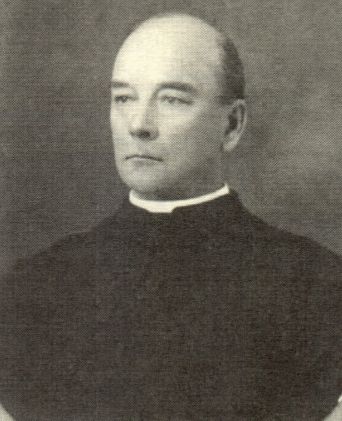THE ECLIPSE CHURCH
by Zelma Scott
Entry T33 from the History of Hooker County Nebraska
with permission of the Hooker County Historical Society

Rev. George C. Ware about 1918 An Episcopal that
started the Eclipse Church.

The Eclipse Church - 1976

The Eclipse Church - 1983

Woman's Auxiliary, Mullen Branch Outside Rev.
Ware's Study about 1918
The following taken from articles in the
Historical Society files were by Mrs Mabel
P. Quinn of recollections by Mrs. Thomas P.
Wood and by Judy Lanka.
The Eclipse Church is 30 miles southwest
of Mullen or 32 miles northwest of Tryon,
Nebraska. In 1987 its Pastor is Rev. Paul
Kondy of First Baptist Church in Arthur,
Nebraska, 40 miles away. The church is built
near the cemetery, where the first burial in
the summer of 1890 was an abandoned
unnamed baby. After a postoffice was estab-
lished in the Chauncey Tucker home and
named "Eclipse" the cemetery became
known as the "Eclipse Cemetery. "
The land for the cemetery and later the
church - originally called the All Saints
Episcopal Church - was donated by Chaun-
cey Tucker.
All of this vast territory was held together
by the community cemetery. There was none
other within a radius of 30 miles or more,
where the only transportation was by horse
and wagon.
Great need for a church building was being
felt. From time to time missionaries of
different faiths drove from house to house
and arranged for meetings in the homes.
Finally a group of people built a sod house for
church purposes on the ranch of Judd Gragg.
Money with which to pay a minister could not
be raised and soon the place was being used
as a granary. Funerals were held in the homes
if a minister could be found.
An Episcopal minister, the Rev. George G.
Ware began holding services in Mullen and
around Eclipse. He began getting people
interested in building a church at the ceme-
tery. A frame building was built, and dedicat-
ed in 1918 by the Rt. Rev. George Allan
Beecher, D.D. The same day baby Bill, son
of Tom and Mabel Quinn was baptized, and
their daughter Myra was the first to be
confirmed in the building.
The women of All Saints were organized in
1910, and a few years after that the Helping
Hand Community Club came into the pic-
ture. Both worked for the upkeep of cemetery
and church. The cemetery association as-
sumed responsibility for the church and in
recent years it is considered non-denomina-
tional. It is now known as the Eclipse Church.
Now high backed wooden benches provide
seating for 100 or more. A propane heating
stove sits near the front to one side, but there
is no electricity. Light is provided by oil
lamps mounted on the walls. There is an old
pump organ on one side of the chancel and
an upright piano on the other. The modern
touch of knotty pine paneling behind the
chancel is centered by a cross of cedar logs
with bark nearly intact. The wainscoted
ceiling is arched to the peak.
"Like a beacon in the Sandhills the Eclipse
Church provides a spiritual light in an
isolated location."



